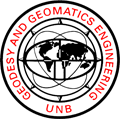|
UNB3m Neutral Atmosphere Delay Model |
The neutral atmosphere delay (or tropospheric delay) is suffered by a GPS signal when it travels through the neutral atmosphere, on its way between satellite and receiver. Because of the nature of the neutral atmosphere, which is composed mainly of gases including water vapor, the signal gets refracted, which means its speed changes (the signal travels more slowly than the vacuum speed of light) as does its path (the signal doesn't travel in a straight line between satellite and receiver antennas). Due to these changes in speed and direction, it takes longer for the signal to reach the receiver's antenna than if it was traveling through a vacuum. This difference in time, which can also be represented in metric units, is the neutral atmosphere delay. The magnitude of this delay depends on several things, and can be quantified based on the profiles of total atmospheric pressure, temperature, and the partial pressure of water vapor. The variation of these quantities at a particular location drives the variation of the delay from one day to another, over the different climate seasons.
UNB3m is a neutral atmosphere delay model, developed
at UNB, whose algorithm is based on the prediction of meteorological parameter
values for a particular location (latitude and height) and day of year, which
are used to compute hydrostatic and non-hydrostatic zenith delays using the
Saastamoinen models. The slant delays (and/or delay rates) are determined using
the Niell mapping functions (or mapping function rates in the case of delay rates).
UNB3m is an improved version of
UNB3. The improvement comes from the use of more realistic estimates of water vapour pressure.
Based on comparisons with radiosonde data from 1990 to 1996 for stations across North America and surrounding territory, UNB3m has a consistent year-to-year
bias in non-hydrostatic delay predictions of around -0.5 cm, which is better than the +2 cm provided
by UNB3. The hydrostatic delays predicted using UNB3m and UNB3 are identical.
Many independent studies have verified the good predictive capability of the UNB3m model.
Detailed information on how
UNB3m model works can be found in the following reference:
Leandro R.F., M.C.
Santos, and R.B. Langley (2006). UNB Neutral Atmosphere Models: Development and
Performance. Proceedings of ION NTM 2006, the 2006 National Technical Meeting
of The Institute of Navigation, Monterey, California, 18-20 January 2006; pp.
564-573. [pdf]
UNB3m is available for
download as a package (UNB3m_pack) containing its several subroutines in both Fortran and MatLab versions along with test programs. The
package can be use to compute slant total neutral atmosphere delays, zenith
delays (hydrostatic, non-hydrostatic and total), Niell mapping function values
(hydrostatic and non-hydrostatic), delay rates, mapping function rates, barometric
pressure, temperature, relative humidity, and mean temperature of water vapour.
These values are a function of day of year, latitude, and height and (for some
parameters) elevation angle. The subroutines are self contained; i.e., they
don't need any auxiliary files. The user has simply to add to his/her software
one or more of the available files and call them in the appropriate way.




